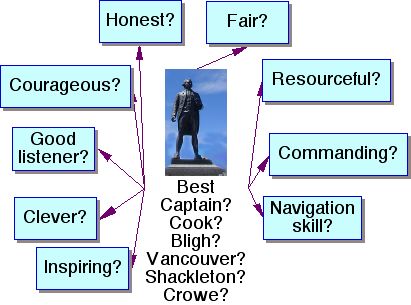Order Jamie's books online with Paypal or a credit card

|
Vol 17|No 5|June|2021
|
|

How long must it be?
by Jamie McKenzie (about author)
In many classrooms when a report is assigned, a student will raise a hand and ask, "How long does it have to be?"
How sad that question seems necessary!
If a research task requires nothing more than the collecting of huge mountains of information, a feat made quite easy to accomplish with copying and pasting, then length might matter, but if the task requires fresh thinking, problem-solving and the generation of good new ideas, then length matters much less than the quality of the thinking.
Imagine the work required to compare and contrast the traits of five ship captains in order to select one of them. This task ranks very high on Bloom's Taxonomy, requiring the skill of evaluation. The student or team of students must agree on criteria like navigational skill and fairness to provide the basis for comparing the captains, and then they must gather examples from their histories to determine which captain excelled or failed.

Russell Crowe was jokingly included above as he was ship captain in the movie "Master and Commander."
The teacher should also identify and announce criteria at the outset of the project that will determine the grade students will deserve. Possibilities might include the folowing:
- Organization
- Logic
- Evidence
- Style
One of the best models to guide students toward improving their writing is the Six Traits of Effective Writing.
The Six Traits of Effective Writing
Students can improve their writing by reviewing each of the following:
Questions to Ask about the Six Traits
Ideas and Content
How can I . . .
- Change the way I write my sentences so that the main ideas stand out more clearly?
- Add evidence or examples so that my ideas stand with enough support?
- Add details, testimony or information which will make my paper more convincing?
- Explain my reasons for not agreeing with opposing ideas and possibilities?
- Improve the logic of my argument?
- Strengthen the connections between ideas, examples and illustrations?
Organization
How can I . . .
- Rearrange the order of the ideas and their supporting evidence to provide a stronger foundation for the argument I am making?
- Make sure each section of the paper does what it is meant to do? Is the introduction inviting? Does it state the issue clearly? Does the conclusion pull together the whole piece? Does it end with some power?
- Pace the flow of the paper so that it slows down and speeds up at the right times?
- Build smoother and clearer transitions and bridges between sections of the paper as well as between the ideas being explored?

© iStock.com
Voice
How can I . . .
- Strengthen my own personal identity in these words and sentences so the reader will hear my strong feelings and beliefs?
- Modify the words so that my passion and caring both shine through with conviction and strength?
- Change the piece so that I anticipate the questions, needs and concerns a reader might have?
- Write with fresh and original insights which I have built and discovered myself without simply borrowing the ideas of others?
Word Choice
How can I . . .
- Substitute stronger words where they are needed?
- Tone down words where they are too strong?
- Replace words which are "overdone" or "over-ripe" or "inflated" with language which is just right?
- Change tired and worn expressions into something new, fresh and original?
- Insert language which appeals, awakens the senses and strikes the fancy of the reader?
- Deepen and sharpen meaning by checking the thesaurus or dictionary for just the right word?
- Eliminate needless repetitions and the flabby use of words?
Sentence Fluency
How can I . . .
- Rewrite sentences to improve their flow from one to another so that my writing has cadence much like a piece of music?
- Introduce variety to the length and type of sentence in ways which seem natural and pleasing rather than forced and awkward? Can I combine some short sentences? Can I replace clauses with phrases?
- Insert bridging words such as adverbs both at the beginning and also within the body of my sentences to avoid stringing overly simple clauses together in a choppy manner?
- Change the words within sentences to eliminate "deadwood" and clarify meaning?
Conventions
How can I . . .
- Place paragraph breaks where they will help to put my message across?
- Employ punctuation that helps the reader know where to pause and how to read my material?
- Check to make sure all rules for grammar, spelling and capitalization have been followed?
Note: This document was inspired by the work of Ruth Culham and Vicki Spandel. Culham's 2003 book "6 + 1 Traits of Writing: The Complete Guide, Grades 3 and Up" is a classic, still available at Amazon.
The model is now supported by Education Northwest at https://educationnorthwest.org/traits/61-trait-writing-resources
|
|
FNO Press is applying for formal copyright registration for articles.
Unauthorized abridgements are illegal. |
|
|

|
|
Copyright Policy: Materials published in The Question Mark may be duplicated in hard copy format if unchanged in format and content for educational, nonprofit school district and university use only and may also be sent from person to person by email. This copyright statement must be included. All other uses, transmissions and duplications are prohibited unless permission is granted expressly. Showing these pages remotely through frames is not permitted.
FNO Press is applying for formal copyright registration for articles. Unauthorized abridgements are illegal.
|
|




